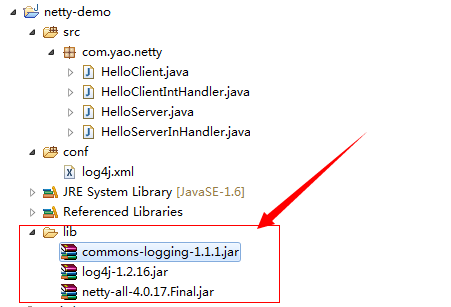netty 学习 (1)
来源:互联网 发布:小米手机移动网络开关 编辑:程序博客网 时间:2024/04/29 14:15
摘要: 本文是学习Netty的第一篇文章,主要对Netty的Server和Client间的通讯机制进行验证。
Server与Client建立连接后,会执行以下的步骤:
1、Client向Server发送消息:Are you ok?
2、Server接收客户端发送的消息,并打印出来。
3、Server端向客户端发送消息:I am ok!
4、Client接收Server端发送的消息,并打印出来,通讯结束。
涉及到的类有4个:
1、HelloServer :server类,启动Netty server
2、HelloServerInHandler:server的handler,接收客户端消息,并向客户端发送消息
3、HelloClient:client类,建立于Netty server的连接
三、 HelloServerInHandler代码如下:
1、Client向Server发送消息:Are you ok?
2、Server接收客户端发送的消息,并打印出来。
3、Server端向客户端发送消息:I am ok!
4、Client接收Server端发送的消息,并打印出来,通讯结束。
涉及到的类有4个:
1、HelloServer :server类,启动Netty server
2、HelloServerInHandler:server的handler,接收客户端消息,并向客户端发送消息
3、HelloClient:client类,建立于Netty server的连接
4、HelloClientIntHandler:client的handler,接收server端的消息,并向服务端发送消息
一、先加入必要的类库:

二、HelloServer代码如下:
package com.yao.netty;import io.netty.bootstrap.ServerBootstrap;import io.netty.channel.ChannelFuture;import io.netty.channel.ChannelInitializer;import io.netty.channel.ChannelOption;import io.netty.channel.EventLoopGroup;import io.netty.channel.nio.NioEventLoopGroup;import io.netty.channel.socket.SocketChannel;import io.netty.channel.socket.nio.NioServerSocketChannel;public class HelloServer {public void start(int port) throws Exception {EventLoopGroup bossGroup = new NioEventLoopGroup();EventLoopGroup workerGroup = new NioEventLoopGroup();try {ServerBootstrap b = new ServerBootstrap();b.group(bossGroup, workerGroup).channel(NioServerSocketChannel.class).childHandler(new ChannelInitializer<SocketChannel>() {@Overridepublic void initChannel(SocketChannel ch)throws Exception {// 注册handlerch.pipeline().addLast(new HelloServerInHandler());}}).option(ChannelOption.SO_BACKLOG, 128).childOption(ChannelOption.SO_KEEPALIVE, true);ChannelFuture f = b.bind(port).sync();f.channel().closeFuture().sync();} finally {workerGroup.shutdownGracefully();bossGroup.shutdownGracefully();}}public static void main(String[] args) throws Exception {HelloServer server = new HelloServer();server.start(8000);}}三、 HelloServerInHandler代码如下:
package com.yao.netty;import io.netty.buffer.ByteBuf;import io.netty.channel.ChannelHandlerContext;import io.netty.channel.ChannelInboundHandlerAdapter;import org.apache.commons.logging.Log;import org.apache.commons.logging.LogFactory;// 该handler是InboundHandler类型public class HelloServerInHandler extends ChannelInboundHandlerAdapter {private static Log logger = LogFactory.getLog(HelloServerInHandler.class);@Overridepublic void channelRead(ChannelHandlerContext ctx, Object msg)throws Exception {logger.info("HelloServerInHandler.channelRead");ByteBuf result = (ByteBuf) msg;byte[] result1 = new byte[result.readableBytes()];// msg中存储的是ByteBuf类型的数据,把数据读取到byte[]中result.readBytes(result1);String resultStr = new String(result1);// 接收并打印客户端的信息System.out.println("Client said:" + resultStr);// 释放资源,这行很关键result.release();// 向客户端发送消息String response = "I am ok!";// 在当前场景下,发送的数据必须转换成ByteBuf数组ByteBuf encoded = ctx.alloc().buffer(4 * response.length());encoded.writeBytes(response.getBytes());ctx.write(encoded);ctx.flush();}@Overridepublic void channelReadComplete(ChannelHandlerContext ctx) throws Exception {ctx.flush();}}四、HelloClient代码如下:
package com.yao.netty;import io.netty.bootstrap.Bootstrap;import io.netty.channel.ChannelFuture;import io.netty.channel.ChannelInitializer;import io.netty.channel.ChannelOption;import io.netty.channel.EventLoopGroup;import io.netty.channel.nio.NioEventLoopGroup;import io.netty.channel.socket.SocketChannel;import io.netty.channel.socket.nio.NioSocketChannel;public class HelloClient {public void connect(String host, int port) throws Exception {EventLoopGroup workerGroup = new NioEventLoopGroup();try {Bootstrap b = new Bootstrap();b.group(workerGroup).channel(NioSocketChannel.class).option(ChannelOption.SO_KEEPALIVE, true).handler(new ChannelInitializer<SocketChannel>() {@Overridepublic void initChannel(SocketChannel ch) throws Exception {ch.pipeline().addLast(new HelloClientIntHandler());}});// Start the client.ChannelFuture f = b.connect(host, port).sync();// Wait until the connection is closed.f.channel().closeFuture().sync();} finally {workerGroup.shutdownGracefully();}}public static void main(String[] args) throws Exception {HelloClient client = new HelloClient();client.connect("127.0.0.1", 8000);}}五、 HelloClientIntHandler代码如下:
package com.yao.netty;import io.netty.buffer.ByteBuf;import io.netty.channel.ChannelHandlerContext;import io.netty.channel.ChannelInboundHandlerAdapter;import org.apache.commons.logging.Log;import org.apache.commons.logging.LogFactory;public class HelloClientIntHandler extends ChannelInboundHandlerAdapter {private static Log logger = LogFactory.getLog(HelloClientIntHandler.class);// 接收server端的消息,并打印出来@Overridepublic void channelRead(ChannelHandlerContext ctx, Object msg) throws Exception {logger.info("HelloClientIntHandler.channelRead");ByteBuf result = (ByteBuf) msg;byte[] result1 = new byte[result.readableBytes()];result.readBytes(result1);System.out.println("Server said:" + new String(result1));result.release();}// 连接成功后,向server发送消息@Overridepublic void channelActive(ChannelHandlerContext ctx) throws Exception {logger.info("HelloClientIntHandler.channelActive");String msg = "Are you ok?";ByteBuf encoded = ctx.alloc().buffer(4 * msg.length());encoded.writeBytes(msg.getBytes());ctx.write(encoded);ctx.flush();}}六、还有log4j.xml文件:
<?xml version="1.0"?><!DOCTYPE log4j:configuration SYSTEM "log4j.dtd"><log4j:configuration xmlns:log4j="http://jakarta.apache.org/log4j/"> <appender name="CONSOLE" class="org.apache.log4j.ConsoleAppender"> <layout class="org.apache.log4j.PatternLayout"> <param name="ConversionPattern" value="[%-5p] [%d] [%t] [%c] %m%n"/> </layout> </appender> <appender name="FILE" class="org.apache.log4j.DailyRollingFileAppender"> <param name="File" value="./log/netty.log"/> <layout class="org.apache.log4j.PatternLayout"> <param name="ConversionPattern" value="[%-5p] [%d] [%t] [%c] %m%n"/> </layout> </appender> <appender name="FILE_ERR" class="org.apache.log4j.DailyRollingFileAppender"> <param name="File" value="./log/netty_err.log"/> <param name="Threshold" value="ERROR" /> <layout class="org.apache.log4j.PatternLayout"> <param name="ConversionPattern" value="[%-5p] [%d] [%t] [%c] %m%n"/> </layout> </appender> <logger name="io.netty" additivity="false"><level value="INFO,DEBUG" /><appender-ref ref="FILE" /><appender-ref ref="FILE_ERR" /><appender-ref ref="CONSOLE" /></logger><logger name="com.yao" additivity="false"><level value="INFO,DEBUG" /><appender-ref ref="FILE" /><appender-ref ref="FILE_ERR" /><appender-ref ref="CONSOLE" /></logger> <root> <level value="debug"/> <appender-ref ref="FILE"/> <appender-ref ref="CONSOLE"/> <appender-ref ref="FILE_ERR" /> </root></log4j:configuration>
总结:
通过上面简单的实例可以发现:
1、在没有任何encoder、decoder的情况下,Netty发送接收数据都是按照ByteBuf的形式,其它形式都是不合法的。
2、接收发送数据操作都是通过handler实现的,handler在netty中占据了非常重要的位置。
3、netty的handler是基于事件触发的,例如当client连接server成功后,client中的HelloClientIntHandler的channelActive方法会自动调用。
0 0
- Netty 学习(1)
- netty 学习 (1)
- netty 学习 (1)
- netty 学习 (1)
- netty 学习(1)
- Netty学习总结(1)——Netty入门介绍
- Netty 学习(5) Netty Example--echo
- Netty 学习(8)Netty Example Telnet
- Netty学习(二)-Helloworld Netty
- 《Netty学习》(一)了解netty
- Netty学习之路(1)
- netty学习1
- netty学习1
- Netty学习笔记:1
- Netty 学习(2)
- Netty 学习(3)
- Netty 学习(4)
- Netty学习(转载)
- [2011][SPM]Visual Attention in Quality Assessment
- java中泛型确切类型的确定
- Sonar project bulk deletion with bash shell to call Sonar web API
- Android计算屏幕宽高
- Unity3D中自带事件函数的执行顺序
- netty 学习 (1)
- 每天一个 Linux 命令(5):rm 命令
- Linux命令--压缩解压缩
- 1112. Stucked Keyboard (20)
- 关于SimpleDateFormat安全的时间格式化线程安全问题
- 【Unity&2D】使用Unity制作2D像素游戏用到的使用插件
- ArcGIS API for JavaScript 4.2学习笔记[6] goTo()地图动画
- [2]Linux内核模块
- Android项目常用控件之GridView


